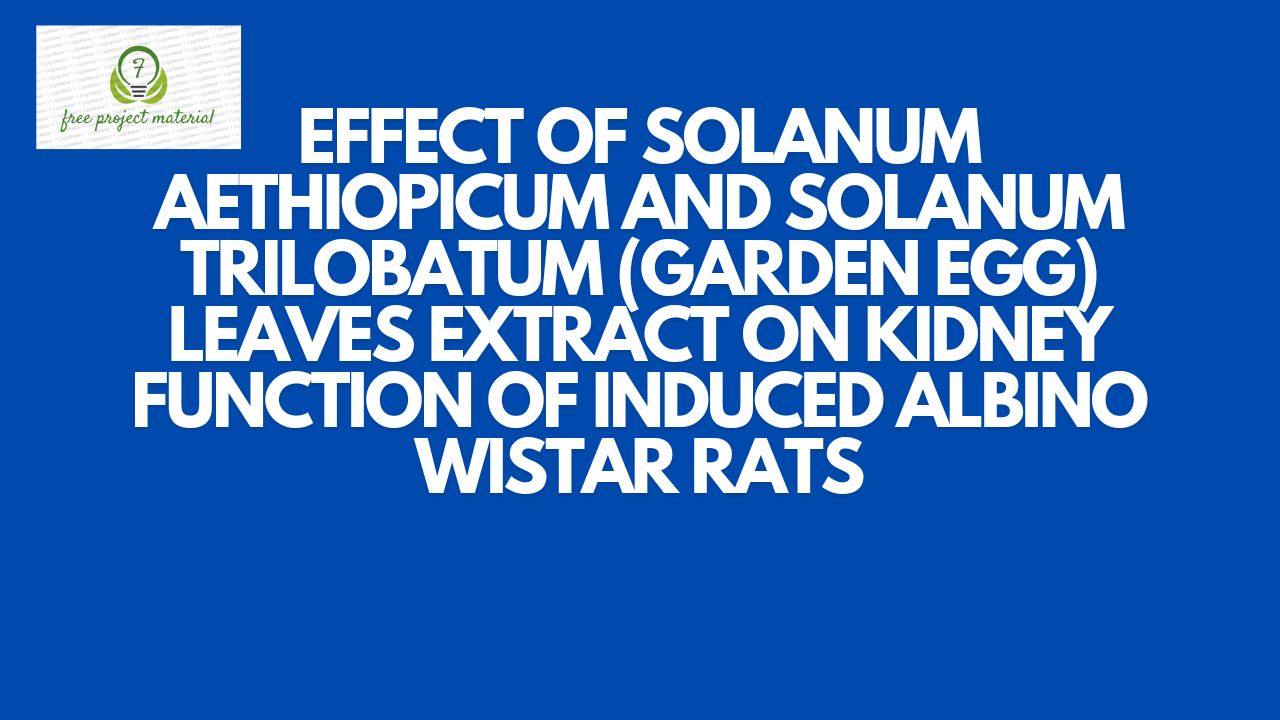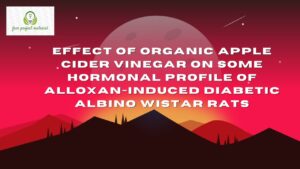ABSTRACT
This study was aimed at determining the effect of ethanolic leaf extract of solanum aethiopicum and solanum trilobatum, on kidney function of Alloxan induced albino wistar rats. Twenty (20) albino wistar rats were randomly assigned into four groups of five rats each. Group I served as the control and was given normal rat fed and al-libutum water only. Group II was treated with standard drug (Metformin) and normal treatment as group I. Group III was given normal treatment as group I and was also treated with ethanolic leaf extract of solanum aethiopicum. Group IV was given normal treatment as group I and administered with combined extract of solanum aethiopicum and solanum trilobatum . Group II, III and IV were pre-induced with alloxan before the commencement of the various treatment. The result revealed a significant increase (p<0.05) in urea and creatinine of group IV when compared to group II, III. It is therefore suggested that solanum aethiopicum and solanum trilobatum leaf extracts may be used to treat diabetic and kidney diagnosis at early stage.
TABLE OF CONTENT
Title Page – – – – – – – – – i
Certification – – – – – – – – ii
Dedication – – – – – – – – – iii
Acknowledgment – – – – – – – – iv
Abstract – – – – – – – – – v
Table of Contents – – – – – – – – v-viii
CHAPTER ONE: INTRODUCTION
1.1 Background of the study – – – – – – 1-3
1.2 Aim and objectives of the study – – – – – 4
1.2.1 Aim – – – – – – – – – 4
1.2.2 Objectives – – – – – – – – 4
1.3 Scope and limitation of the study – – – – – 5
CHAPTER TWO: LITERATURE REVIEW
2.1 Scientific Classification and Description of
Solanum aethiopicum – – – – – – 6-8
2.2 History of Solanum aethiopicum – – – – – 8
2.3 Origin and Botanical Description of solanum trilobatum – 9-10
2.4 Nutritional Profile of Solanum aethiopicum – – 10-14
2.5 Chemistry and Allergies of the Plant – – – 14-15
2.6 Health Benefits of Solanum aethiopicum – – – 16-19
2.7 Risks of Consumption of Solanum aethiopicum – – 19-20
2.8 Kidney Function Test Parameters and Clinical Significance- 21
2.8.1 Creatinine – – – – – – – – 21-22
2.8.2 Urea – – – – – – – – – 22-23
2.8.3 Blood Urea Nitrogen (BUN) – – – – – 23
2.8.4 Protein – – – – – – – – 23-24
2.8.5 Creatinine Clearance Rate – – – – – 24-25
2.8.6 Urea Clearance – – – – – – – 25-27
CHAPTER THREE: MATERIALS AND METHOD
3.1 Materials and reagents – – – – – – 28
3.1.1 Chemical used/ make – – – – – – 28
3.1.2 Preparation of reagent – – – – – – 29
3.1.3 Equipment used – – – – – – – 29
3.2 Method – – – – – – – – – 30
3.2.1 Sample collection and preparation – – – – 30-31
3.2.2 Experimental design and Treatment – – – – 31-32
3.3 Data Collection and analysis – – – – – 32-33
3.4 Analytical procedures – – – – – – 33-36
3.5 Statistical Analysis – – – – – – – 36
CHAPTER FOUR: RESULTS AND DISCUSSION
4.1 Results – – – – – – – – 37-38
4.2 Discussion – – – – – – – – 38-39
CHAPTER FIVE: CONCLUSION AND RECOMMENDATION
5.1 Conclusion – – – – – – – – 40
5.2 Recommendation – – – – – – – 41
References
CHAPTER ONE: INTRODUCTION
1.1 Background of the Study
Plant as source of medicine are getting wider acceptance of their natural sources, case of access, convenience to use and cost-effectiveness. Precisely about 80% of world population use traditional medicine to treat their aliments (WHO, 2013; Edwer-kuponiyi, 2013; Ameh et al., 2010).
Generally, large numbers of herbal medicine consumed for short term disease treatment are considered natural and safe in our communities. In addition, several medicinal plants previously tested scientifically were reported to be safe even above 500mg/kg dose (Al-Afifi et al., 2018); Porwal et al., 2017; Khan et al., 2016; Patric-Iwuanyanwu et al., 2012). However, according to the experts opinion, natural does not implies absent of toxicity. In many instances medicinal plants were found to cause side effects, adverse effects and even drugs interactions (Nath and Yadav, 2015). Also, chronic toxicity studies data from experiment on the use and consumption of medicinal plants are scarcely available (Eran et al., 2016; NRC, 2006).
Solanum aethiopicum (L.), family Solanaceae is popularly known as garden egg or Ethiopian eggplant, Ethiopian nightshade, mock tomato or latter tomato. In Nigeria, it is called Gauta by Hausa, Igbagba by Yoruba, Afufa by Igbo and Nyah Ibibio tribes (Elatta et al., 2017, Eze and Kanu, 2014, Anosike et al., 2021, Chinedu et al., 2011, Osei et al., 2010, Burkill, 2000).
Solanum aethiopicum fruit is used as food and can be eaten raw. The fruit is given to the visitors as a special gift to celebrate marriage and new born babies. Solanum aethiopicum is used traditionally to threat mental disorders. In traditional vegetable soup (Eletta et al., 2017; Eze and Kanu, 2014; Anosike et al., 2012; Chinedu et al., 2011, Ose et al., 2010, Burkill, 2002). The fruit and leaf decreases body weight and blood glucose (Emilaju and Chinedu, 2016; Okafor et al., 2016). In addition, the fruit reduces cholesterol level (Chinedu et al., 2013). The leaf of Solanum aethiopicum possesses laxative activity (Saba et al., 2012). The fruit have shown anti-ulcer property (Chioma et al., 2011). The fruit also has antioxidant activity (Eletta et al., 2017).
Kidney plays an important role in the maintenance of water volume electrolyte and acid-base balance in the body. Kidney serves as an important function of excretion of products of metabolism and other harmful substance.
Renal or kidney function test are done to assess the functional capacity of kidney (blood flow to the kidney, glomerular filtration and tubular function). The aim of renal function testes is to detect impairment of renal function as early as possible. The kidney function can be assessed by examination of blood urine. In urine examination, simple routine examination of urine volume, pH concentration test or specific gravity test, osmolality and presence of certain abnormal constituents (proteins, ketone bodies, blood, glucose) and in blood or serum analysis, estimation of blood urea nitrogen, serum creatinine, protein and electrolyte.
1.2 Aim and Objectives of the Study
1.2.1 Aim of the Study
The aim of this research is to investigate the effect of Solanum aethiopicum (garden egg) leaves extract on kidney function of induced Albino Wistar rats with diabetes.
1.2.2 Objectives of the Study
The objectives of this research work include the following;
- To determine the effect of Solanum aethiopicum laef extract on Creatinine and urea activities in the induced albino wastar rats.
- To determine the effect of metformin on creatinine and urea.
- To determine the effect of solanum aethiopicum and solanum trilobatum leaf extract on creatinine and urea activities in the induced albino wistar rats.
- To examine the medicinal uses of Solanum aethiopicum and Solanum trilobatum leaf extract.
- To make recommendation base on the result of this study.
1.3 Scope and Limitation of the Study
The scope of the study only covers the effect of Solanum aethiopicum leaves extract on kidney function of induced albino wistar rats with diabetes and it is limited from other parameters outside the kidney function parameter due to financial and time constraint.
The Solanum aethiopicum leaves sample was collected at the botanical farm in the institution located at Ikot Osurua, Ikot Ekpene Local Government in Akwa Ibom State.



